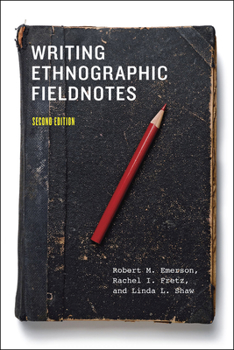Writing Ethnographic Fieldnotes
Select Format
Select Condition 
Book Overview
In this companion volume John van Maanen's Tales of the Field, three scholars reveal how the ethnographer turns direct experience and observation into written fieldnotes upon which an ethnography is... This description may be from another edition of this product.
Format:Paperback
Language:English
ISBN:0226206831
ISBN13:9780226206837
Release Date:December 2011
Publisher:University of Chicago Press
Length:320 Pages
Weight:0.97 lbs.
Dimensions:0.7" x 6.0" x 9.0"
Related Subjects
Anthropology Cultural Education Instruction Methods Language Arts Literature & Fiction Pedagogy Politics & Social Sciences Rhetoric Schools & Teaching Science Science & Math Science & Scientists Science & Technology Social Science Social Sciences Specific Demographics Textbooks Words, Language & GrammarCustomer Reviews
4 ratings
Noteworthy Resource
Published by Thriftbooks.com User , 16 years ago
It's interesting that books on fieldwork tend to exclude extended discussions of note-taking as a part of fieldwork. The focus of many guides on fieldwork methods usually is on completing audio or video interviews and on the use of photography in fieldwork. This book fills this gap in research methodology. The writers show good, practical techniques for taking notes during ethnographic and oral history field research. More importantly, they convincingly demonstrate how creating good fieldnotes is essential to completing good ethnographic studies. Each section of the book blends practical ideas with theoretical generalizations in ways that not only show readers how to complete field research, but the discussion also reveals why these techniques are useful. The chapter that provides ways to turn fieldnotes into written ethnographies is an especially helpful discussion of a challenging task. In this particular chapter, and in the book in general, readers can find ideas that can also be applied to the use of other field-generated resources such as structured audio/video interviews and photo sessions. This book is also valuable as a resource for understanding and examining various written ethnographic studies. In this respect, the insights offered by Emerson, Fretz, and Shaw give readers good ideas for evaluating written ethnographies and useful perspectives for understanding the process of completing ethnographically-grounded research and how ethnographic study contributes to the representation of culture.
Perfect for master's level studies
Published by Thriftbooks.com User , 16 years ago
The text is exactly as described and promised. A very practical tool for the bachelor's or master's student.
An Excellent Resource
Published by Thriftbooks.com User , 17 years ago
Emerson, Fretz, and Shaw have put together not only an excellent handbook for writing ethnographic fieldnotes, but an insightful study of the practical issues confronting anyone doing interpretative writing about culture. The book's primary focus is on how to effectively take and maintain fieldnotes. They appropriately begin at the ground by discussing how to take jottings and other quick notes, providing memory cues for the later write up of complete fieldnotes. Always keeping the focus on the task of writing, while balancing that with the task of honest and rigorous reporting, they give excellent advice for how to create a clear record of your field experience. While their focus is primarily on an ethnographic style of careful observation of interactions, their ideas remain useful to those with other theoretical concerns. Because they are always keeping an eye toward the end product of a finished, written document, this book also provides and excellent resource for how to use your fieldnotes in order to write a finished ethnography. But this is not just an excellent book for ethnographic fieldworkers. Reading the book not only gave me solid ideas for my fieldwork, but also for the task of reading and note-taking around text-based and image-based culture. Additionally, I see this as an invaluable tool for someone engaged in more journalistic research, and for those of us who teach and tutor writing.
A "how-to" manual for turning observation into publication
Published by Thriftbooks.com User , 22 years ago
Writing Ethnographic Fieldnotes was written to fill a gap in ethnographic methods training - students are seldom guided through the process of turning notes jotted down as they do observation into publishable ethnographic documents. Not laden with academic jargon, the easy flowing text makes this book readily accessible to the undergraduate student - but the content is such that even an experienced ethnographer can benefit.True teachers, Emerson, Shaw and Fretz (UCLA faculty) show just as much of the process as they tell. Step by step, readers are walked through the process of turning initial chicken scratches jotted down on scrap paper to publishable ethnographic documents. Rarely will you find more than a page between excerpts from real fieldnotes.The authors recognize that every field situation is different and ethnographers rarely, if ever, find themselves in ideal situations for writing. Thus, they explain the tensions that constantly pull at ethnographers and also what things will become much easier as ethnographers gain experience. They discuss how to balance observing with writing, and demonstrate that how you write fieldnotes (what you emphasize, point-of-view used, quality of description, representing community members' voices) is just as important as what you write.Redundancy might be a weak point, but overall the re-explaining of things in two or three different ways serves only to make the reader experience and assimilate the process of writing fieldnotes. Readers can then naturally employ the procedures rather than constantly referring to the book as a "checklist" when doing fieldwork. I would definitely recommend this book to anyone seeking to understand the worldview and customs of another culture, or doing social research within their own culture. Even if your goal is not to do anthropology or to publish ethnographic documents, turning your experiences and observations into written text helps you to process things. Writing also helps you gain insights about the community you are working with by increasing your observational skills. You will not regret taking time to read Writing Ethnographic Fieldnotes.




